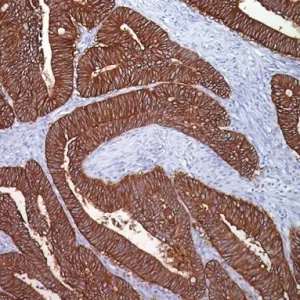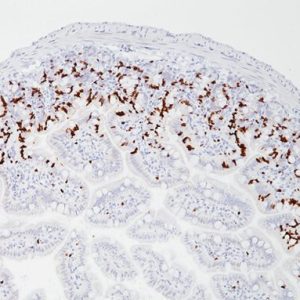Description
Napsin A is a pepsin-like aspartic proteinase. It is expressed in type II pneumocytes and in most lung adenocarcinomas and some renal cell carcinomas. Studies have shown that Napsin A is a more sensitive and specific marker than TTF-1 and is extremely specific for lung adenocarcinomas (1-6). Most studies show Napsin A is highly specific for lung adenocarcinoma versus lung SqCC (1-4).
SPECIFICATIONS
Specifications
| WEIGHT | N/A |
|---|---|
| DIMENSIONS | N/A |
| INTENDED USE | IVD |
| SPECIES REACTIVITY | Dog, Human, Mouse, Rat, Sheep |
| SOURCE | Rabbit Monoclonal |
| CLONE | BC15, Biocare Clone |
| ISOTYPE | IgG |
| ANTIGEN | Napsin A |
| LOCALIZATION | Cytoplasmic (granular) |
| POSITIVE CONTROL | Lung adenocarcinoma |
DATASHEETS & SDS
INTERNATIONAL
REFERENCES
1. Mukhopadhyay S, Katzenstein AL. Subclassification of non-small cell lung carcinomas lacking morphologic differentiation on biopsy specimens: Utility of an immunohistochemical panel containing TTF-1, napsin A, p63, and CK5/6. Am J Surg Pathol. 2011 Jan; 35(1):15-25.
2. Bishop JA, Sharma R, Illei PB. Napsin A and thyroid transcription factor-1 expression in carcinomas of the lung, breast, pancreas, colon, kidney, thyroid, and malignant mesothelioma. Hum Pathol. 2010 Jan; 41(1):20-5. Epub 2009 Sep 8.
3. Jagirdar J. Application of immunohistochemistry to the diagnosis of primary and metastatic carcinoma to the lung. Arch Pathol Lab Med. 2008 Mar; 132(3):384-96.
4. Dejmek A, et al. Napsin A (TA02) is a useful alternative to thyroid transcription factor-1 (TTF-1) for the identification of pulmonary adenocarcinoma cells in pleural effusions. Diagn Cytopathol. 2007 Aug; 35(8):493-7.
5. Suzuki A, et al. Napsin A is useful to distinguish primary lung adenocarcinoma from adenocarcinomas of other organs. Pathol Res Pract. 2005; 201(8-9):579-86.
6. Center for Disease Control Manual. Guide: Safety Management, NO. CDC-22, Atlanta, GA. April 30, 1976 “Decontamination of Laboratory Sink Drains to Remove Azide Salts.”
7. Clinical and Laboratory Standards Institute (CLSI). Protection of Laboratory workers from occupationally Acquired Infections; Approved guideline-Third Edition CLSI document M29-A3 Wayne, PA 2005.







Reviews
There are no reviews yet.